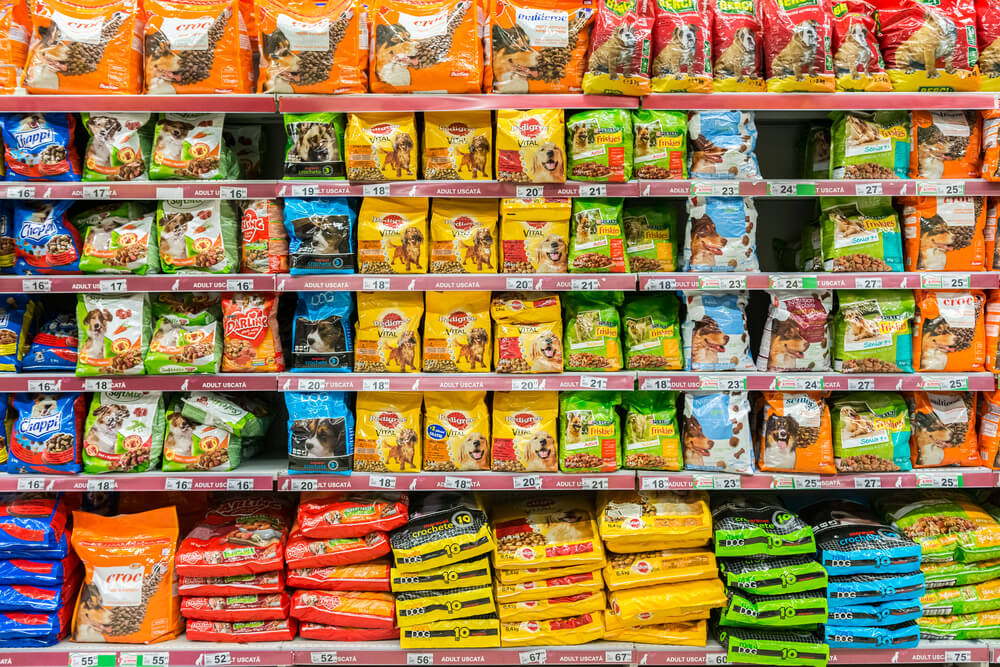Blog, General dog nutrition
April Fools! Don’t be tricked by persuasive dog food labelling claims
Most dog owner are highly responsive to products similar to those they use for themselves. As a result, humanization and premiumization are hot trends in the dog food industry.
Manufacturers comply to these demands by making a variety of claims from “Premium” to “Grain Free” to “Wholesome” and beyond. While some of these products may be higher quality, the terms used are chosen at the whim of a marketing department keen to make you feel good about buying it for your dog.
Below is a list of some of the most common front-of-packaging marketing claims you need to watch out for.
Product name
Many dog owners buy a food based on the presence of a specific ingredient. Manufacturers know this so together with attractive photographs they often incorporate the name of an ingredient in the product label to highlight its inclusion. For example, the front packaging may say ‘with chicken’ and you, quite naturally, will assume that the product you are purchasing contains a significant amount of chicken – right? Wrong.
Even if the name of a product includes the phrase “with [ingredient]” or “contains [ingredient]”, the food is only required to have “no less than 4% of the named ingredient”, prior to cooking, i.e. before water is cooked off in the production process.
You can learn more about the component claims and guidelines by heading to this link:
https://fediaf.org/images/FEDIAF_labeling_code_2019_onlineOctober2019.pdf
Natural
Of course, the implication of ‘natural’ is that it already exists in nature and therefore it’s healthy. But arsenic exists in nature and you wouldn’t want to add that to your dog’s breakfast. This claim is made possible because the FDA doesn’t define what ‘natural’ actually means and the AAFCO’s definition is so broad that it encompasses everything other than artificial preservatives, flavours and colouring agents and synthetically produced vitamins and minerals. Even when these latter two ingredients are used, the label can still read “natural with added vitamins and minerals”.
Holistic
No doubt meant to motivate our ‘inner hippy’ this term is also meaningless. Most people’s understanding of ‘holistic’ is wholeness or completeness and yet food that is promoted under the holistic banner has been shown to contain the same ingredients, grown or raised in the same way as other non-holistic products. They have no unique properties at all.
Human Grade
No food produced in a pet food factory, no matter how good it may be, can be legally classed as human grade. Many manufactures get around this fact by instead claiming that their products are “made from human grade ingredients”, “with human grade meat” or “ingredients fit for human consumption”. But again the statement doesn’t really mean anything.
Although many ingredient’s may enter a manufacturing process as “human grade” based on the way it was produced and transported (every producer of those ingredients must be licensed to perform those tasks), the manufacturer must then meet stringent hygiene and processing requirements for them to remain “human-grade”. Few pet food companies can meet these criteria.
Premium or Gourmet
We love our dogs. Dog food manufacturers know this and so they add “premium” or “gourmet” to the label so we feel as though we are giving our dog the very best. More often than not there is no real difference between the premium product and the non-premium product other than the price.
Organic
It’s impossible for a complete dry dog food to be “100% organic” because vitamin and mineral supplements must be added and they can’t be organically produced.
If a manufacturer states their dog food is “organic” the food must contain at least 95% organic ingredients and must identify the organic ingredients in the ingredient list i.e. “organic brown rice”, “organic chicken”, “organic poultry meat” etc.
If a food is labeled “Made with organic ingredients” – it’s a different rule again. This time the food must contain at least 70% organic ingredients and again, the organic ingredients must be identified in the ingredients list.
It is also worth noting that genuinely organic ingredients are significantly more expensive to produce which means that the dog food will almost certainly contain less meat than non-organic dog food and cost more.
Hypoallergenic
“Hypoallergenic” is another popular claim and it’s used to describe any ‘limited ingredient food’ that doesn’t contain anything commonly linked to allergies. This may sound sensible, especially if you have a dog with a sensitive tummy or itchy skin; until you realise that any individual dog can be allergic to any protein source or any particular ingredient – limited or not. So ‘novel’ or ‘limited-ingredient foods’ can’t really be considered non allergenic.
For these reasons, in my opinion, ‘hypoallergenic’ is misleading. While nothing ever works for all dogs, I’ve had much better luck managing food allergies and sensitivities in dogs using a hydrolyzed food or home-prepared diet.
Conclusion
Looking at the front of packaging claims has many pitfalls and is very subjective to intentional manipulation by the manufacturer. Don’t let clever marketing fool you into thinking a food is healthier than it is! Familiarise yourself with a variety of ingredients and what the label on a dog food tells you and what the label doesn’t tell you.
If you are interested in learning more I suggest you download my book ‘Choosing the Best Commercial Dog Food‘. This eBook presents facts and findings on a variety of ingredients, pet food marketing as well as debunking some popular myths.

